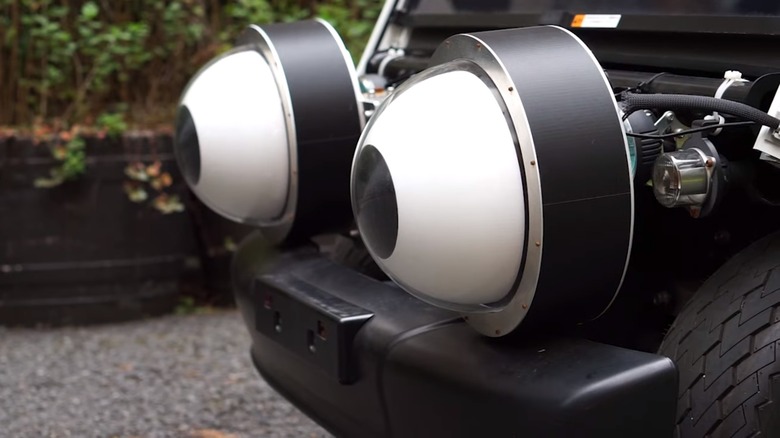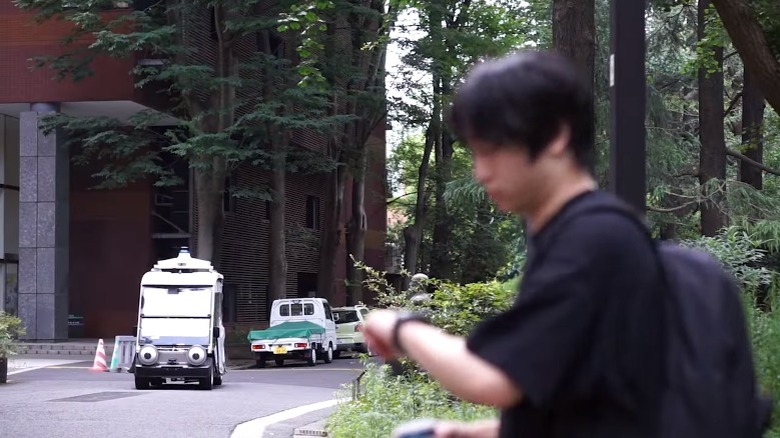Why New Self-Driving Cars Could Have Giant Robotic Eyes On The Front
Self-driving technology has been a hot-button topic for a number of years, and as with any new technology, there are a lot of questions that need to be answered — particularly around safety. Those safety questions are often punctuated by dangerous or even fatal incidents involving pedestrians and motorcycles (via CNN).
Similarly to the acoustic generators that the NHTSA requires EVs to activate at low speeds, there may be interesting, alternative strategies to address pedestrian safety — playing on human nature and behavioral science. While the product development teams are working on making the artificial intelligence behind automated driving safer, a team of researchers at the University of Tokyo published a paper containing some interesting research. Coming at the problem from a different angle, the researchers investigated interactions between self-driving cars and pedestrians in an attempt to make the vehicles more predictable to people on the street. A press release indicates some interesting findings that may be particularly useful to automakers — if they can make it look less goofy, that is.
How eyes convey intention
It's fairly common knowledge that the human brain is quite adept at identifying faces, which is why we tend to see faces in inanimate objects, and even infer personalities in those imagined faces. A paper titled "Can Eyes on a Car Reduce Traffic Accidents?" found that this affinity for facial recognition — along with our keen eye for body language — can be used to help other road users predict what a self-driving car is about to do.
The researchers used virtual reality to simulate a scenario wherein 18 participants had to make a decision about crossing at a sidewalk while a self-driving car the size of a golf cart was approaching. To simulate hurried behavior, the decision had to be made within three seconds each time. The virtual vehicle was equipped with a pair of eyes on the front bumper that could articulate and move to indicate its attention. They ran four permutations of the same scenario — one where the car's eyes looked at the participant, indicating it had noticed them and intended to stop, another where it made no eye contact, indicating it had not noticed them, and two scenarios wherein the car had no eyes, so the participant didn't know whether it intended to stop.
The idea is that the car could indicate it has seen the pedestrians waiting to cross, giving the pedestrian confidence to cross knowing that the car will yield for them. Surprisingly, the results proved this hypothesis correct. Adding eyes to the car reduced the rate of incorrect decisions by 64%.
But nobody wants cars with silly googly eyes
Let's be honest — looks play a big part in the automotive purchase decision-making process, and it would be a shame to see technology hindered because of looks. For as long as there have been cars, there have been cars that have had faces, and they've always ended up as the butt of the joke at some point. Even the researchers involved in the study acknowledged this, stating in the press release that the research is merely a starting-off point, but that it would be best if engineers or designers came up with a more elegant solution. Case in point, a poll conducted during the study revealed that most female participants felt safer when the eyes were looking at them, while male participants mostly felt like they were in more danger as a result of the eyes.
Aesthetics aside, a 60% reduction in potentially fatal incidents is nothing to scoff at, and certainly warrants the attention of designers and automakers if they do actually care about pedestrian safety, so it certainly makes sense to pursue the idea if self-driving cars are ever to become mainstream.


